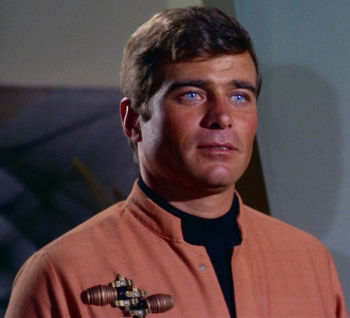Cochrane, Zefram

Zefram Cochrane (TOS-31)

Zefram Cochrane (ENT-01-02)

Zefram Cochrane (ST-08)
Zefram Cochrane was born on Earth, and lived through World War III before inventing the first warp-capable vessel. Of all the great inventors who have ever lived on the planet Earth, few can claim to have had as much impact on the course of human history as Zefram Cochrane. The amazing coincidence of choosing to make his first warp flight in his experimental ship, the Phoenix, on the same day that a Vulcan survey ship passed through Earth’s solar system, led to one of the most important moments in human history—the first meeting with an alien race. Cochrane’s discoveries ensured his place in history and ushered in a new era of peace and prosperity for mankind. In the following centuries, his theories and discoveries were taught in schools, some of which were named after him; his name was also given to units of measurement relating to warp physics.[2]
At the time of his greatest triumph, Zefram Cochrane was an unconventional scientist, craggy in a distinctive way, who favored wearing long overcoats and a cap studded with pins. His unkempt appearance certainly did not equate with having one of the greatest minds in human history, or with the reverence in which posterity would come to hold him. In truth, Cochrane was far from being a perfect role model.[2] However, even when drunk—which was often[5]—Cochrane was not without intelligence and a certain charm. He also enjoyed rock ‘n’ roll music of the mid-20th century, and considered it a vital accompaniment when he made his first test flight of the Phoenix. One of his first gestures of friendship toward the Vulcans was to introduce them to the music he enjoyed so much.[2] Though he claimed not to care about the Phoenix, his sentiments may have been more of a philosophical reaction to war experiences and disappointments throughout his life than to an actual lack of concern. Despite his cynical approach to life, he took the opportunity to make the test flight that was to change Earth’s history forever.[2]
Cochrane had great trouble coming to terms with the awe with which visitors from his planet’s future viewed him. The idea that the launch site for the first warp flight would become an historical monument with a 20-meter-tall marble statue erected in his honor, and that textbook chapters and schols would be named after him, made him feel unworthy of the acclaim. He was a private man who did not think of himself as a hero or savior, or anything but a guy attempting to make money from a scientific discovery. His dream was not to usher in a new era for humankind, but to retire to a tropical island where the women ran around naked. His motives were not the most noble and he had no desire to live up to an idealized reputation bestowed upon him by people who didn’t even know him. Ten years after his historic flight, however, his experiences had significantly changed him; Cochrane was once quoted as saying, “Don’t try to be a great man. Just be a man, and let history make its own judgments.” The Cochrane of April 2063 called this “rhetorical nonsense;” but the advice made him think, and perhaps this was what helped him to take his place in history by piloting mankind’s first warp flight.[1]
Despite his resolve, Cochrane never fully came to terms with the fame that surrounded him. By his own admission, Cochrane regarded himself as a loner, and sometime after First Contact, he traveled to the new colonies in Alpha Centauri to escape the adulation and fuss that surrounded him. In 2119, at the age of 89, Cochrane dedicated the Warp Five Complex in Northern California,[3] then left on his personal spaceship, the Bonaventure, wanting to die alone in space, and he was presumed to have done so.[1, 4] However, in 2266, Captain James T. Kirk of the U.S.S. Enterprise NCC-1701 was surprised to find Cochrane living on a planetoid in the Gamma Canaris region, nearly 150 years after he was believed to have died. His appearance had changed radically, and despite being 237 years old he looked like a man in the prime of health.[1]
Cochrane had been discovered drifting in space and near death by an alien life form known only as the Companion. This sentient entity, made up of a cloud of ionized hydrogen and strong electrical impulses, brought Cochrane to its planetoid and rejuvenated him, effectively giving him immortality. The Companion also provided Cochrane with food, water, gardens, and everything he needed to survive. Cochrane was able to make a house for himself equipped with an electric heating unit for a stove, a climate control device, and comfortable furniture, all by cannibalizing parts from his spaceship. At first, Cochrane enjoyed his solitary life and was able to engage in a non-verbal communication with the Companion. When he wished to make his feelings known, he would clear his mind, and the Companion would approach him, emitting a melodic hum before enveloping him in a symbiotic joining and ascertaining his wants and needs. This life suited Cochrane for a time, but he was prevented from leaving by a dampening field apparently created by the Companion. After 150 years, Cochrane felt he would die if he did not have some form of human interaction, and he hoped the Companion would allow him to leave. However, the life form had grown to love Cochrane and had no intention of letting him go. Instead, when the Starfleet Shuttlecraft Galileo II passed nearby, the Companion forced it to land so Cochrane would have others to interact with. Captain Kirk, Spock, and Dr. McCoy were on the shuttle, along with Commissioner Nancy Hedford, who had contracted Sakuro’s disease, a very rare terminal illness. Cochrane was delighted to finally have someone to talk to, and was more than ready to leave, especially when Kirk told him about the discoveries mankind had made in the intervening years.[1]
However, the Companion overpowered them and they were forced to recalibrate the universal translator to reason with their captor. Despite their pleas, the Companion refused to let them go, but one important fact emerged: the universal translator adopted a female voice for the Companion. Kirk pointed out to Cochrane that this female entity was in love with him, as she prioritized his safety and desires above all else. At first, Cochrane was appalled by the idea, feeling that it went against all standards of decency and morality. He described the Companion as an “emotional vampire,” invading the privacy of his mind to feed on him. Cochrane’s disgust indicated a lack of the broadmindedness that Kirk and the others showed. Cochrane could only see past this disgust when the Companion merged with the dying Nancy Hedford and took her form, purging all traces of the disease from her body. At once the Companion understood the loneliness that Cochrane had felt, while Cochrane now felt able to accept her love. Cochrane also felt he could not just abandon her, and decided to stay on the planetoid, where they would both live out a normal human lifespan. Kirk reminded Cochrane that there was a galaxy out there waiting to honor him, but that was something he had never wanted. At Cochrane’s request, Kirk did not report his discovery to Starfleet, and his true fate remains unknown to the rest of the Federation.[1] Portrayed by Glen Corbett[1] and James Cromwell[2, 3].
References
- 1. “Metamorphosis.” Star Trek, Episode 31. Television. 10 November 1967.
- 2. Star Trek: First Contact. Film. 22 November 1996.
- 3. “Broken Bow.” Star Trek: Enterprise, Episodes 01-02. Television. 26 September 2001.
- 4. “Future Tense.” Star Trek: Enterprise, Episode 42. Television. 19 February 2003.
- 5. “Regeneration.” Star Trek: Enterprise, Episode 49. Television. 7 May 2003.
Leave a Reply
Categories
- Animated Series (60)
- Articles (28)
- Books (447)
- Cast & Crew (79)
- Comics (22)
- DS9 (328)
- Early Voyages (125)
- Education (5)
- Enterprise (373)
- Excelsior (36)
- Food (19)
- Games (223)
- Klingon (70)
- Library (1,543)
- Logs (593)
- Lost Era (55)
- Medicine (18)
- Merrimac (1)
- Mirror (35)
- Miscellaneous (13)
- New Frontier (54)
- Next Generation (635)
- Original Series (681)
- Personnel (436)
- Places (369)
- Politics (12)
- Recreation (10)
- SCE (41)
- Science (1)
- Shatnerverse (9)
- Ships (455)
- Site Updates (98)
- Starfleet Academy (86)
- Stargazer (42)
- STO (61)
- Technology (45)
- Titan (59)
- To Boldly Go (1)
- TV/Film (214)
- Uncategorized (4)
- Vanguard (76)
- Voyager (236)
- Weapons (27)
- Xenology (54)